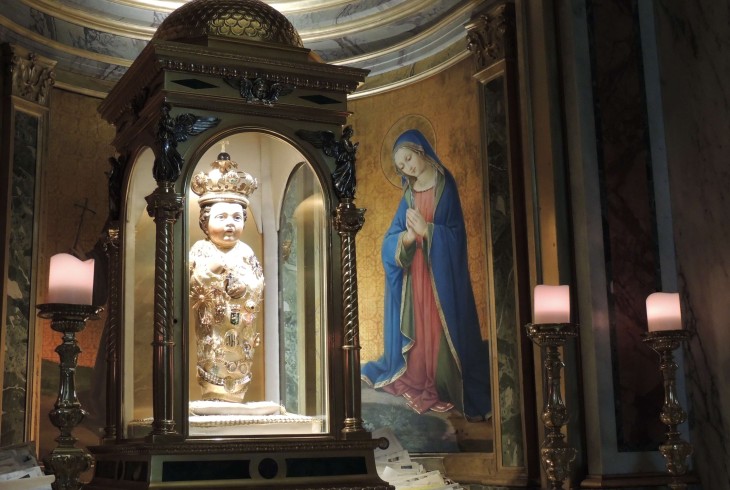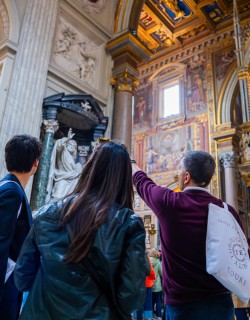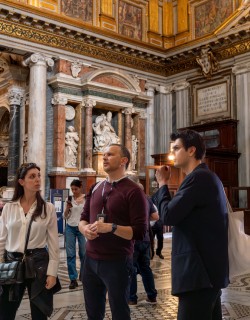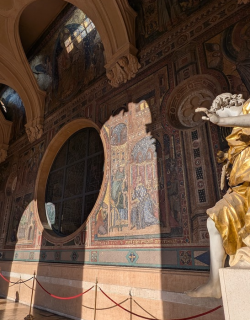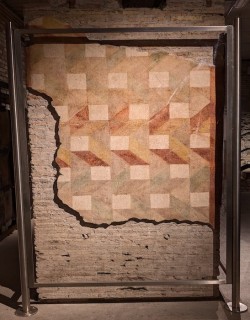On the 2nd of February 1994, Romans woke up to a disconcerting headline in the national newspapers: “RUBATO IL BAMBINELLO DELL' ARA COELI.” The “Santo Bambino” (Holy Child) in question was a little wooden statue about 60 cm tall depicting the young Christ Child wearing a crown and precious vestments, and was one of Rome’s most venerated and beloved Christian images. The theft sent shockwaves across the city, and, despite a concerted investigation, not a trace of the sculpture has been uncovered from that day to this.
Undeterred, the Franciscan monks in charge of the church of Santa Maria in Aracoeli - home to the statue for the last 500 years - had an exact replica of the Bambinello created and placed in the now empty chapel. Romans soon took the copy to their hearts, and accorded it with the same degree of veneration as they lavished on the lost original.
These days, the theft has been largely forgotten, and the Santo Bambino continues to work miracles and provide spiritual succor to the legions of pilgrims who arrive each year to pay homage to the sculpture, just as they have been doing for centuries.
But just who is the Santo Bambino di Aracoeli, known to locals simply as Er Pupo de Roma - Rome’s Little Lad?
Miraculous Origins
To find out, we need to travel back in time half a millennium or so, across seas and continents to the Middle East. Here, a pious Franciscan friar stationed in the Holy Land decided, for reasons lost to historical record, to carve a little sculpture of the infant Christ Child swaddled in robes.
The most precious aspect of the sculpture was the material from which it was carved: a piece of wood hewn from the olive trees in the Garden of Gethsemane, where Jesus and his apostles anxiously awaited the foretold day of his arrest and subsequent crucifixion.
The story goes that our artist, his work nearly done, had his own moment of doubt when it came to painting the wooden sculpture. Questioning his ability to do lifelike justice to his subject, he prayed for divine inspiration before falling into a deep sleep. When he awoke, his prayers were answered. The statue was expertly decorated: cheeks shining with youthful vigor, robes glittering with jewels, and hair bouncing with lustrous curls - the work, it seemed, of angels.
Divinely painted images are not uncommon in Catholic belief: known as acheiropoieta, or icons made without human hands, amongst their number you might recognize the Veronica Veil and the Shroud of Turin. Adding to the holy aura of our bambinello, the friar reportedly decided to baptize the miraculous image in the waters of the river Jordan, in imitation of Christ himself.
A Legendary Trip to Rome
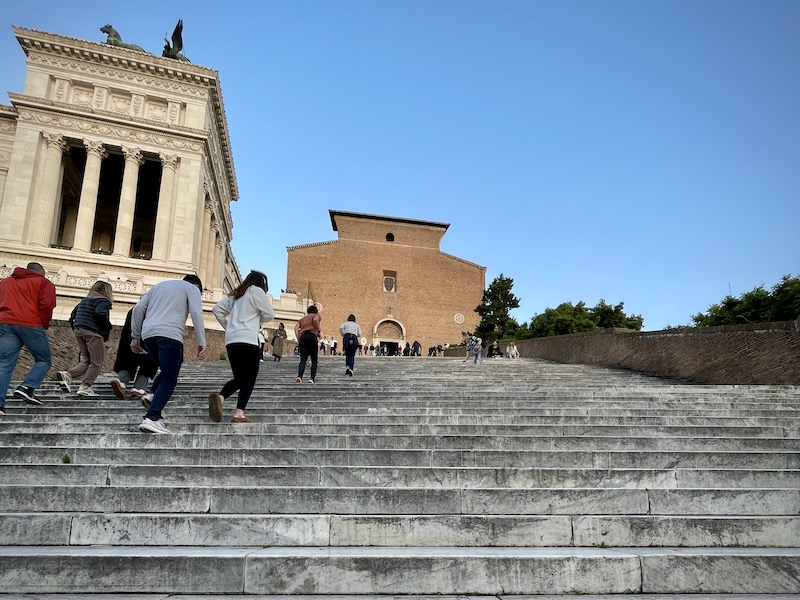 The church of Santa Maria in Aracoeli in Rome
The church of Santa Maria in Aracoeli in Rome
The now marvellously adorned statue of the infant Christ was soon packed off to the Franciscan headquarters in Italy. Disaster struck on the high seas, however, when a massive wave sent the ship on which the Bambino was travelling to the briny depths.
The statue was beginning to exert its miracle-working powers, however, and was safely deposited unscathed on the Lazio coastline alongside the boat’s passengers. Soon afterwards it found its way to Santa Maria in Aracoeli in Rome, the most important Franciscan church in the city.
The Miracle Worker
Deposited in a chapel in the fabulous church, the Santo Bambino began to enjoy a reputation in the city as a miracle-working icon. According to numerous early-modern sources, hopeful supplicants arrived daily at the basilica in hope that they would be healed of maladies, become pregnant or find love. According to legend, those coming to the statue for help can gain a clue as to whether their request will be granted in the bambino’s lips: if there is hope the lips will turn red, whilst they will turn white if the case is a lost cause.
In thanks for the many blessings received, the faithful began adorning the statue with precious gems and jewels, so that the icon positively glitters. In the 18th century one observer wrote that the Bambino was extraordinarily “enriched with emeralds, sapphires, topazes, amethysts, diamonds, and other precious ornaments,” including a dress fastener adorned with 162 diamonds bound in silver worth an eye-watering 580 scudi.
In 1800 the fabulously wealthy Prince Alessandro Torlonia took to travelling around the city in his sumptuous carriage alongside the statue every Thursday, bringing the bambino to the homes of the sick who were too ill to make their own way to Santa Maria in Aracoeli.
Records attesting to the great esteem in which the Bambino was held in Rome are legion. In 1798 the statue was taken by soldiers of the French army who were besieging the city, but was returned safely to the populace after a Roman noblewoman, Serafina Petrarca, successfully sweet-talked the Napoleonic invaders into handing it over after paying a large ransom out of her own pocket.
In 1895, the Vatican formally recognized the cult of the Santo Bambino, decreeing that the statue be crowned with a fabulous coronet.
The Nativity Crib
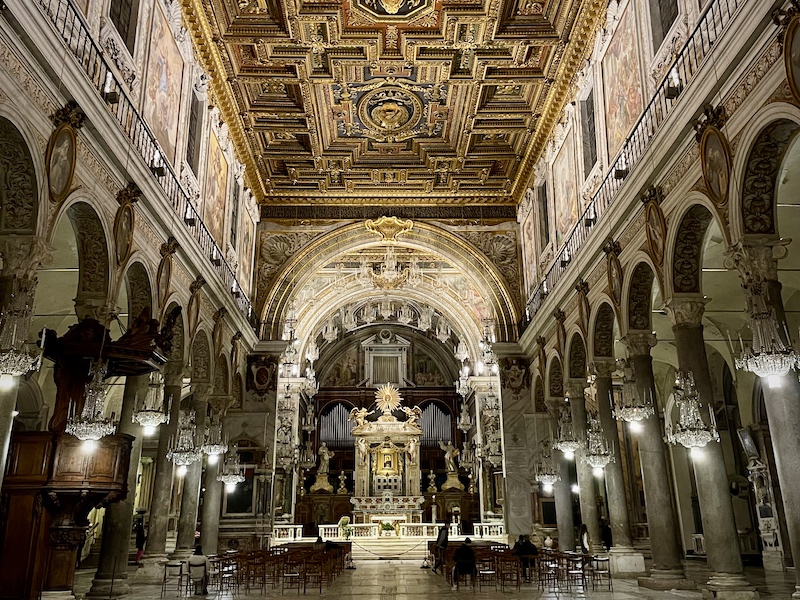
Each Christmas, the Santo Bambino is moved from the chapel to become the centerpiece of the elaborate Christmas crib, or presepio, that graces the church. Here the child is placed in the arms of a seated figure of the Virgin Mary and surrounded by other figurines depicting characters from the Nativity tale - the three kings, the shepherds, various animals and more. To guard against another theft, volunteers from the local police corps stand watch over the presepio.
Events culminate on the 6th of January, the feast of the Epiphany, when the Bambinello is carried in procession from the church to the piazza del Campidoglio, where the statue is held aloft to bless the city for the coming year.
The Theft
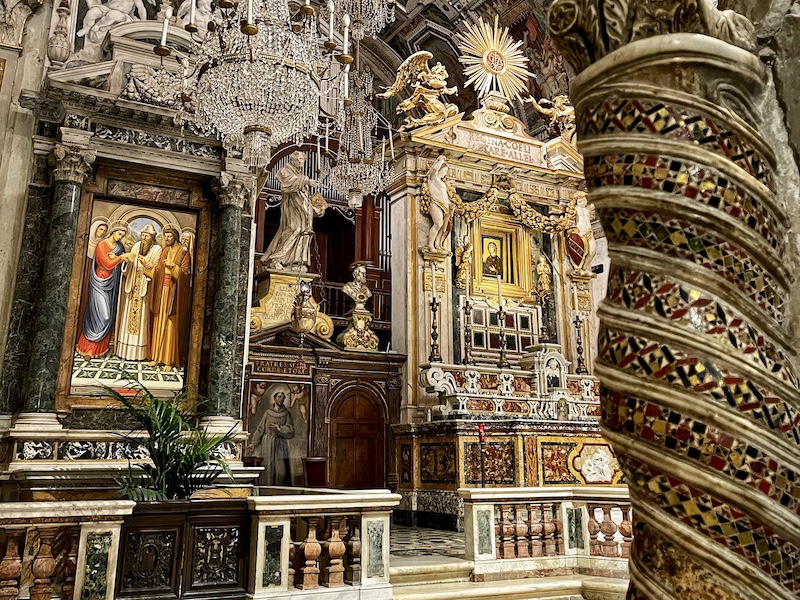
And so back to that February day in 1994. After being displayed in Santa Maria in Aracoeli’s Nativity crib for the Christmas period, the Santo Bambino was poised to be returned to the safety of its securely protected display case. As bad luck would have it, this was the moment the thieves, disguised as workmen, chose to strike, making off with both the sculpture and the precious jewels and gold that adorned it in a daring smash-and-grab raid.
Initially Italian police were confident that the relic would be swiftly returned, hypothesising that the thieves were after the ornaments and not the Santo Bambino itself. They reasoned that the statue was far too famous to be sold on the black market, and expected at worst that a ransom request would be made for its safe return. Alas, their hopes were ill-founded. It seems likely now that the robbery was committed on commission, and that the Bambinello occupies secret pride of place in the collection of an unscrupulous antiquarian.
Rome’s Little Lad lives on, however, in the replica that has by now taken on all of the mysterious aura of the original. For residents of the Eternal City, it wouldn’t be Christmas without paying a visit to the Santo Bambino of Aracoeli!
MORE GREAT CONTENT FROM THE BLOG:
- The Best Christmas Cribs (Presepi) in Rome
- Where to See the Best Christmas Lights in Rome
- Christ is Born: Pinturicchio’s Nativity Fresco in Santa Maria del Popolo’s Della Rovere Chapel
- Everything you Need to Know About Visiting Rome
- 6 Most Ancient Churches in Rome
- How to visit the Colosseum in 2024: Tickets, Hours, and More
- 7 Things you Need to Know About the Trevi Fountain
- Visiting the Vatican Museums and St. Peter's Basilica: The Complete Guide
- 9 Things You Need to Know About the Pantheon in Rome
- 5 Reasons to Explore Italy with Through Eternity
